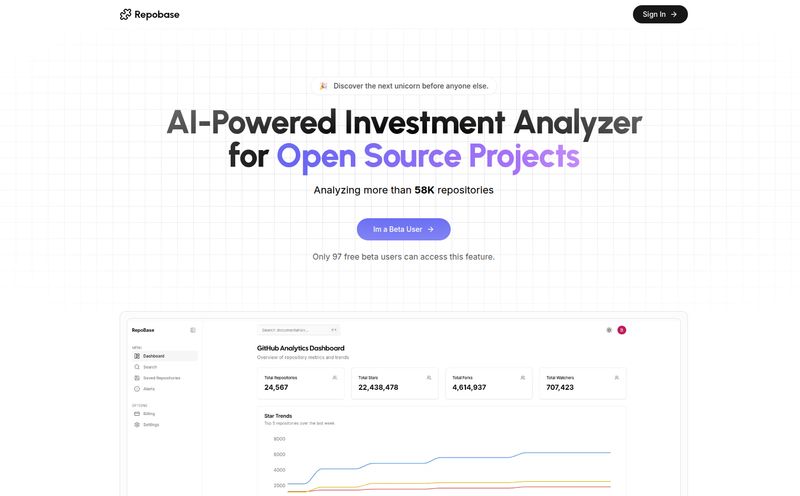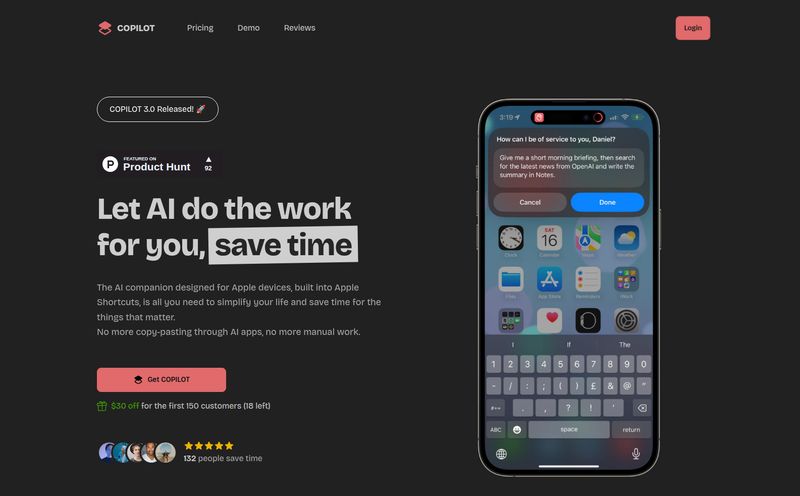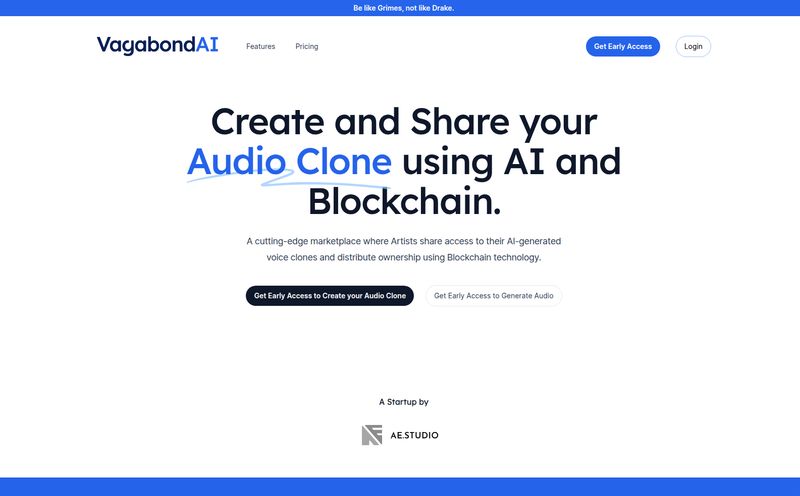If you’ve spent any time in the digital marketing or SEO world, you know the drill. You’re swimming, no, drowning in data. Google Analytics reports, search console exports, CPC campaign spreadsheets, CRM dumps... it’s a deluge. For years, my life was a cycle of exporting CSVs, wrestling with pivot tables in Excel until my eyes blurred, and trying to build something coherent in Data Studio before the data was already two days old.
It's the classic data paradox: we have more information than ever, but less time to make any sense of it. So when I see a new tool pop up that claims to use AI to do the heavy lifting, my ears perk up. But I’m also skeptical. We’ve all seen tools that promise a revolution and deliver a slightly fancier spreadsheet. The latest one to cross my desk is Anilyst, an AI-powered platform that says it can turn your raw data into shiny, actionable insights just by... talking to it.
Talk to my data? In plain English? That sounds less like data science and more like something out of Star Trek. So, naturally, I had to take a look.
So, What is Anilyst, Really?
Okay, cutting through the marketing copy, Anilyst positions itself as your data analysis sidekick. The core idea is simple: you upload your raw data (think CSV files for now), and its AI engine takes over. It's built to eliminate the tedious, soul-crushing manual work that I personally believe is responsible for 90% of the grey hairs on data analysts' heads. It’s not just about making charts; it’s about understanding what’s in the data.
It’s designed to be an interpreter, translating your messy datasets into clean visualizations and, more importantly, clear answers. Instead of you hunting for the needle in the haystack, Anilyst supposedly runs a giant magnet over the whole thing and hands the needle right to you. A pretty bold claim, if you ask me.

Visit Anilyst
The Magic Wand: Talking to Your Data in Plain English
This is the feature that got my attention. The Natural Language Query. For anyone who hasn't spent years learning SQL or the arcane formulas of spreadsheet software, this is the holy grail. The idea that you can just type, “What were our top 5 performing campaigns in Q2 by click-through rate?” and get an instant, accurate answer is… well, it’s a game-changer.
I’ve seen this attempted before, and it can be clunky. But when it works, it fundamentally changes who can perform data analysis. It breaks down the wall between the “data people” and the “ideas people.” Suddenly, the account manager, the content strategist, or the small business owner can interrogate their own data without a middleman. This democratizes insight, and honestly, it’s about time. No more waiting two days for the analytics team to get back to you. You just ask.
This is more than a convenience; it's a shift in workflow. It encourages curiosity. When you can ask follow-up questions as quickly as you can think of them (“Okay, now show me that but only for campaigns targeting the UK”), you start to uncover patterns you would have never found otherwise.
Visualizing Success: It's More Than Just Pretty Charts
Anyone can make a pie chart. Heck, Excel has been doing that for decades. The point of a modern data viz tool isn’t just to make charts, but to make them interactive and insightful. Anilyst seems to get this. It promises not just standard graphs but interactive dashboards where you can click, filter, and drill down into the data in real-time.
This is crucial. A static chart tells you what happened. An interactive dashboard helps you understand why it happened. Seeing a sales spike is one thing; being able to click on that spike and instantly see it was driven by a single traffic source from a specific blog post is an entirely different level of intelligence. This is where you move from reporting on the past to shaping the future. It’s the difference between a history book and a strategy guide.
The Heavy Lifters: AI Features That Actually Matter
AI is a term that gets thrown around so much it’s almost lost all meaning. But Anilyst specifies a few capabilities that are genuinely powerful if they work as advertised.
Key AI Capabilities in Anilyst
We're talking about things like predictive analytics, which tries to forecast future trends based on your historical data. Imagine feeding it your sales data and getting a reasonable projection for next quarter. Then there’s anomaly detection. For anyone running CPC campaigns, this is huge. It’s the AI watchdog that flags when a cost-per-click suddenly skyrockets or a landing page conversion rate plummets for no apparent reason. It finds the problems before they show up on your boss’s weekly report.
It also does pattern recognition and automated reporting, which are fantastic time-savers. It’s like having a junior analyst on staff 24/7 who never gets tired and never complains about having to update the Monday morning report. Again.
Handling the Grunt Work of Data Processing
Here’s an industry secret: about 80% of any data analysis project is just cleaning the data. It's the unglamorous, painstaking work of fixing formatting errors, removing duplicates, and handling missing values. Anilyst claims it does automatic data cleaning. If this is true and reliable, this feature alone could be worth its weight in gold.
It also handles large datasets and supports multiple file formats, which is table stakes for any serious tool these days. The promise of real-time data streaming is also there, which would make it incredibly powerful for monitoring live campaigns or website traffic.
The Catch: What’s Missing and The Big Price Question
Alright, it can't all be sunshine and automated rainbows. There are a couple of things that give me pause. On their features list, things like Version Control and Custom Scripts are marked as 'Coming Soon'.
Now, custom scripts might be a power-user feature, but version control is pretty important for teams. It's what stops one person from accidentally overwriting a crucial report someone else built. Its absence suggests the platform is still young, which is fine, but it's something to be aware of. You’re buying into potential, not a fully mature ecosystem just yet.
And then there’s the elephant in the room: the price. As of my review, there is no public pricing page. You have to get in touch for a demo or a quote. I get it, it’s a classic B2B SaaS strategy, especially for tools aiming at the enterprise market. But it's a bit of a barrier. I always prefer transparent pricing tiers, it lets me quickly assess if a tool is even in the right ballpark for my budget. Without it, it’s hard to say if this is an affordable tool for a freelancer or a five-figure solution for large corporations.
So, Who Is Anilyst Actually For?
Based on what I've seen, Anilyst feels perfectly targeted at marketing teams, business analysts, and managers at small-to-medium-sized businesses. It’s for people who are data-curious but not necessarily data-fluent in a technical sense. They need answers from their data now, and they don't have a data scientist on speed dial.
If you're a hardcore data scientist who lives in Python and builds custom ML models from scratch, this might feel a bit limiting. But if you’re a marketing director who just wants to understand campaign ROI without taking a three-month course on Tableau, Anilyst could be exactly what you’re looking for.
It’s a tool built for speed and accessibility, trading some deep-level customization for incredible ease of use. And in my book, thats a trade-off many businesses are more than willing to make.
Frequently Asked Questions About Anilyst
Do I need to know how to code to use Anilyst?
Absolutely not. That’s kind of the whole point. With the Natural Language Query feature, you can ask questions in plain English. The platform is designed to be accessible for non-technical users.
What kind of data can I analyze with Anilyst?
Currently, it's heavily focused on structured data formats like CSV files. The documentation mentions support for multiple file formats and real-time data streaming, so its capabilities are likely expanding to include database connections and APIs in the future.
How does Anilyst compare to something like Tableau or Power BI?
Anilyst seems to be focused more on speed and ease of use, particularly with its AI and natural language features. Tools like Tableau and Power BI are incredibly powerful and customizable but come with a much steeper learning curve. Anilyst is for getting quick, AI-driven insights, while the others are more for deep, complex business intelligence dashboarding.
Is my data secure with Anilyst?
While specific security protocols aren't detailed in the provided info, any reputable SaaS platform handling customer data operates with robust security measures, including encryption and access controls. When you request a demo, this would be a great question to ask their team directly. I even noticed a Vercel Security Checkpoint when trying to access the site, which shows they are taking access security seriously.
What does Anilyst cost?
Pricing information isn't publicly available. You'll need to contact their sales team or request a demo to get a quote. This usually means the pricing is customized based on your team's size and usage needs.
What features are currently missing?
As of now, features like version control for collaborative work and the ability to run custom scripts are listed as 'Coming Soon'. This indicates the platform is still actively developing its feature set.
Final Thoughts on Anilyst
I started out skeptical, but I'm leaving cautiously optimistic. Anilyst is tapping into a real, significant pain point. The promise of taking the drudgery out of data analysis and making powerful insights accessible to anyone is incredibly appealing.
Yes, it's a young platform. Yes, the lack of public pricing is a little annoying. But the core concept—a smart, conversational interface for your data—is so strong. If the execution is as good as the idea, Anilyst could easily become an indispensable tool in the modern marketer's and analyst's toolkit. It’s one I’ll definitely be keeping my eye on.
Reference and Sources
- Information and features sourced from the official Anilyst website.
- For more on the trend of AI in data analytics, check out Gartner's research on Augmented Analytics.



